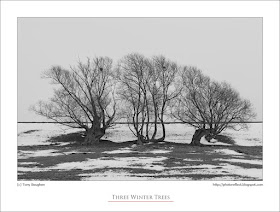click photo to enlarge
Anyone with an interest in the history of English church architecture, visiting St James at Deeping St James in Lincolnshire for the first time, will immediately think, "What's been going on here?" It's not the basic shape of the church that you see when you walk through the churchyard gate that provokes the question: that's very conventional with the west tower, nave and aisle, chancel and south porch. What's puzzling is, firstly, the elevation of the aisle with its short buttresses topped by pilasters with no pinnacles above, the size of those windows, and the suspicious "Gothic" of the tower. Stepping inside reveals that it was once a major church, in fact a Benedictine Priory founded by Thorney Abbey in 1139. The seven bay, Late Norman south arcade (see small photograph), with its thirteenth century triforium looks like it belongs in a much larger church. Did it ever link up with a structure of the same magnitude elsewhere in the building, or was it the start of a grandiose idea that was then slimmed down? And what about that tower. Stylistically it is Georgian Gothic, a stripped down version of the older style made palatable for a new age. It was built after the old tower collapsed in 1717, the victim of bad foundations due to repeated flooding over the centuries. There is some question over when precisely the new tower was erected, but 1732 is scratched on the exterior west wall, and this is the likely date rather than 1819 which is more carefully carved beneath the parapet.
Stepping inside reveals that it was once a major church, in fact a Benedictine Priory founded by Thorney Abbey in 1139. The seven bay, Late Norman south arcade (see small photograph), with its thirteenth century triforium looks like it belongs in a much larger church. Did it ever link up with a structure of the same magnitude elsewhere in the building, or was it the start of a grandiose idea that was then slimmed down? And what about that tower. Stylistically it is Georgian Gothic, a stripped down version of the older style made palatable for a new age. It was built after the old tower collapsed in 1717, the victim of bad foundations due to repeated flooding over the centuries. There is some question over when precisely the new tower was erected, but 1732 is scratched on the exterior west wall, and this is the likely date rather than 1819 which is more carefully carved beneath the parapet.As with much of the building in the Gothic style that the seventeenth and eighteenth century added to medieval churches we are prompted to ask whether it is a survival or a revival. That is to say, did the builders simply continue to build in the style that was for centuries the only one applied to churches, or did they deliberately forsake the classical idiom of much public building of the period and modishly seek to revive a "forgotten" style. Historians of art and architecture make much of the revival of Gothic in the eighteenth century by the likes of Horace Walpole, William Kent, Robert Adam, James Wyatt and the rest. However, it never entirely went away. Provincial churches sometimes used it in the seventeenth century, as did some colleges at Oxford and Cambridge when they were being extended. It may be that the people at Deeping St James wanted a tower that both reminded them of the one that fell down, but also showed that they were "up to date".
photograph and text (c) T. Boughen
Photo 1
Camera: Canon
Mode: Aperture Priority
Focal Length: 28mm
F No: f7.1
Shutter Speed: 1/500 sec
ISO: 100
Exposure Compensation: -0.33 EV
Image Stabilisation: On






















